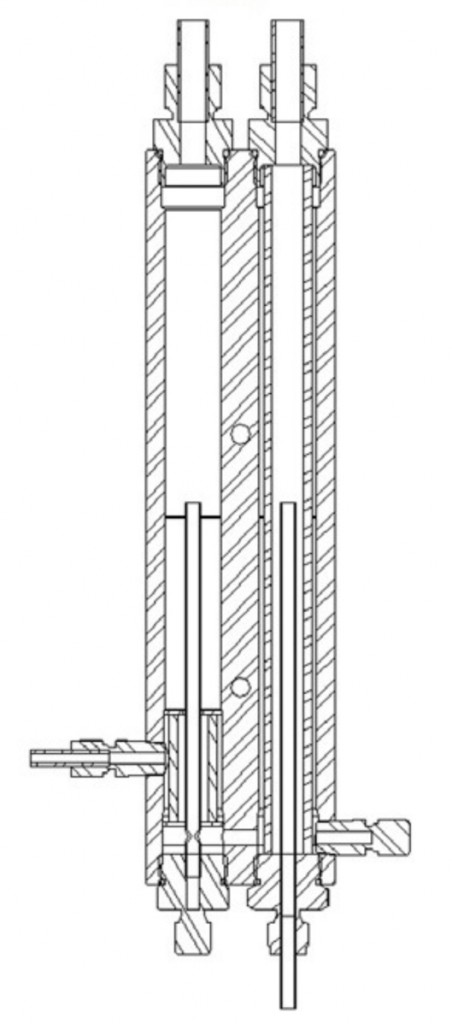The SS 1200-LF-S2-DG is recommended for liquid samples with heavy gas contamination. These uniquely demanding applications require the highest liquid-gas separation.
The 1200-LF-S2-DG reverses the role of kinetic energy separation to separate the heavy liquids as components of interest from the gas contaminants.
The 10” hydrophobic filter in the first chamber separates the gas from the liquid in the fast loop. Any residual carryover of gas is separated kinetically in the second chamber. The liquid sample is further polished by the 2.25” Borosilicate glass Fluorocarbon filter with a resin binder. This unique material is generally recognized as the best filter material to remove gas from liquids.
Kinetic Separation Technology is the most innovative technology available today for sample conditioning.
The Sheffield patented dual chamber separator provides maximum separation of heavy particulate. Although kinetic energy will physically separate impurities, it will not alter the chemical composition of the sample.
Features |
Benefits |
|
| Extremely Versatile | Operates across a wide range of pressure, flow rates, and temperatures | |
| Hydrophobic Fluorocarbon Teflon® lined filters | Can handle significant amounts of free water or particulate without clogging | |
| Requires no utilities | Can be used anywhere | |
| Operates at 2psi or less differential pressure | Will not push water through the hydrophobic filter | |
| Dual chamber construction | Maximizes filtration and separation: longer filter life | |
| No moving parts | Less maintenance, greater reliability | |
| Straight Fittings with O-ring Seals | Easier filter changes | |
| No internal obstructions in first chamber | Minimal backpressure |
Also available as a component of the Sheffield Separator Sample Conditioning System Panel
The Sheffield Separator uses kinetic energy to separate the representative analyzer sample from impurities found in a process stream. This is accomplished by establishing a flow path through the 1st chamber and reversing the flow of a relatively small Bypass sample. Solid contaminants and immiscible liquids in the liquid samples will not negotiate this complete reversal of flow direction and exit the bottom of the separator. The Kinetic Energy caused by this reversal initially removes the impurities from the Bypass stream through gravity and inertia. To further effect this separation and filtration a second kinetic chamber with a hydrophobic filter polishes the sample. The second chamber also experiences Kinetic Separation and removes the remaining impurities from the slip stream. The sample is lighter than the immiscible liquids and solids (particulates) in liquid samples.
How It Works
S 1200-LF-S2-DG
Stainless Steel Liquid Filter with 2 Filters in Series
The SS1200-LF-S2-DG model separator reverses the orientation of the chambers to allow the heavier liquid phase fast loop sample to enter the lower inlet of the first chamber. This stream reverses direction and flows back down to the Inlet of the Second Chamber. Gas that was part of the original fast loop continues upward and is removed through rotameters at the uppermost end of the first chamber.
The First Chamber of the Sheffield Kinetic Separator is designed for installation directly in-line to the Fast Loop sample transport system or in the Bypass Loop. Most of the contaminates are separated in the first chamber. This chamber is aided with a special 10” 2 or 15 micron Teflon®-lined, hydrophobic, self-cleaning low pressure drop filter.
The Second Chamber separates and filters only the relatively small amount of Slip Stream sample going to the analyzer which greatly enhances filter life. The 2.25” Borosilicate glass Fluorocarbon filter element in the bottom of this chamber allows the final gas contaminates to separate from the liquid. The remainder of the upper chamber allow the knock out effect to further separate and remove very small bubbles with the fast loop. Finally, both chambers exit the top of the separator to a common juncture with the return flow or vent.
Maximum Pressure: 2,000 PSIG
Minimum Pressure: 2 PSIG – Vacuum application with pump or eductor
Maximum Temperature: 300° F
Pressure Drop: 2 PSIG
Flow Rate: The flow rate specified for the sample system is sufficient for the separator. For best results, the first chamber flow should exceed that of the second chamber.

